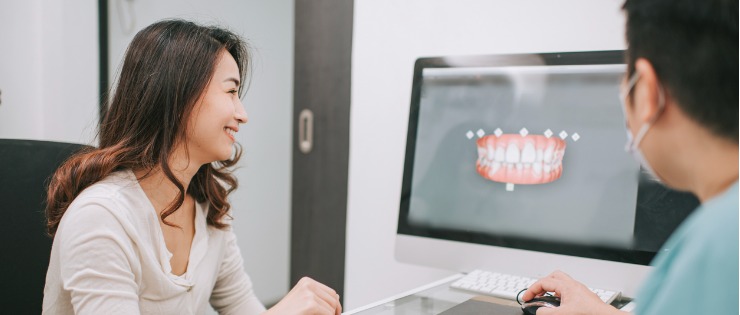How Does Teledentistry Work?
A teledentistry appointment is organised to ensure patients can meet with a dentist via an agreed video platform.
Real-Time Teledentistry
Videoconferencing occurs between a dental professional and the patient to see, hear and communicate with each other live. Known as synchronous, this type of appointment takes place over a video call.
Store and Forward Teledentistry
Known as asynchronous, it involves the exchange of clinical information and images collected and stored in telecommunication equipment. One dental practitioner may forward this information to another, who will consult and plan treatment for their patients. This type of treatment often occurs with a local dentist collecting the information and collaborating with a specialist dentist. The patient may not be present when the specialist diagnoses and recommends treatment.

When Did Teledentistry Start?
In April 2020, during the first wave of COVID-19 in Australia, the Australian Dental Association introduced a new item number, 919, on the Australian Schedule of Dental Services and Glossary to allow for telehealth consultations. The new item number was needed to cover for situations where a patient was in isolation as a result of testing positive to COVID-19 or had been exposed to someone with the virus and needed to stay home but needed urgent dental care.
The teledentistry item number is for use by patients who are existing patients or have been referred by another practice. At the beginning of the pandemic, dentists were restricted by the procedures they could perform due to the need to reduce the risk of the virus spreading.
HIF was one of the first health insurers to pay rebates against the new teledentistry item number.
While teledentistry has only been used in practice since the start of COVID-19, the concept of teledentistry has been discussed in theory for more than a decade. A study was conducted in 2012 looking at teledentistry as a potential to eliminate the disparities in oral health care between rural and urban communities.
Australia’s vast size means many rural residents don’t have easy access to a dentist. A teledentistry appointment avoids the need for patients to travel many hours to see a dentist. Many people living in remote regions don’t get to see a dentist for years, but if a teledentistry appointment is available, they may be more likely to see a dentist. Teledentistry is also a good substitute in cases of emergency, so a dentist can quickly assess the problem and prescribe medicine. In some countries, a teledentistry appointment is a cost-effective option, particularly as dentistry can be quite expensive, and allows people access to dental health care who otherwise couldn’t afford to see a dentist.

Teledentistry for Prevention
The lack of preventative dental visits causes a need to visit hospital emergency departments when the pain of a tooth infection becomes so great. In 2019-2020, the rate of potentially preventable hospitalisations due to dental conditions was 2.2 per 1,000 in Canberra and as high as 3.3 per 1,000 in South Australia. During the same period, around 67,000 hospitalisations were recorded for preventable dental conditions with earlier treatment. If teledentistry appointments can be used to reduce even a small number of hospitalisations, the savings to the Australian economy can be considerable.
Teledentistry Used for General & Specialist Dentistry
Teledentistry can be used for all types of dental treatment from general to specialist dentistry.
General Dentistry
Dental injuries, oral lesions and toothaches can be diagnosed and oral health care advice can be provided via teledentistry.
Prosthodontist
A prosthodontist can use teledentistry to evaluate the ridges, supporting tissue structure and remaining teeth. A local general dentist can complete the casts, photographs and x-rays and send them to the specialist and laboratory for preparing the prosthetics.
Endodontology
Teledentistry can be used to supply information to an endodontist to detect root canal orifices. General dentists can be assisted by specialist endodontists to detect and treat patients.
Orthodontics
The teledentistry industry is likely to increase in the future through orthodontic treatment. Teledentistry is used to screen, refer, consult, and manage orthodontic patients. The pre-treatment including extractions and impressions can be undertaken by a local general dentist under the direction of a remote orthodontist.
An orthodontist can meet with patients via teledentistry to discuss discomfort, irritation of braces, and displaced rubber bands rather than the patient visiting the orthodontist’s office for a short appointment.
Oral Surgery
Assessment and diagnosis of impacted and semi-impacted molars is possible using teledentistry. A store and forward method of records can be used as a pre-operative tool.

Teledentistry Overseas
Telephone-based dentistry has been used in Europe since 1997. During COVID-19, teledentistry increased with oral health providers able to consult, diagnose, and treat patients safely. It’s expected that the European teledentistry market will increase from $245m in 2019 to $920m in 2027.
In the US, teledentistry is used in several public programs:
Toothbrush monitoring to reduce the incidence of sepsis. It’s estimated that $400 million could be saved on sepsis treatment by improving toothbrushing.
Second opinion consultations to allow patients to check on a proposed treatment before they agree to proceed.
Smile Survey which allows patients to be scored on their smile and provide advice on oral hygiene and recommendations to improve their smile.
Education from dental hygienists for at-home dental care.
Future of Teledentistry
While the average city-dwelling Australian may not have heard of the terms telehealth or teledentistry before the pandemic, it’s likely that these services will remain long after the pandemic has passed. Teledentistry allows patients access to general and specialist dental services who may not be able to access if it was only available at a dental surgery.
Teledentistry at HIF
Our dental cover is designed to encourage and reward regular maintenance of your teeth. So, no matter which extras option you choose, you can enjoy great benefits, regardless of your provider. From oral examinations, x-rays, scales and cleans, to fillings and extractions, you'll find a policy that works for you.